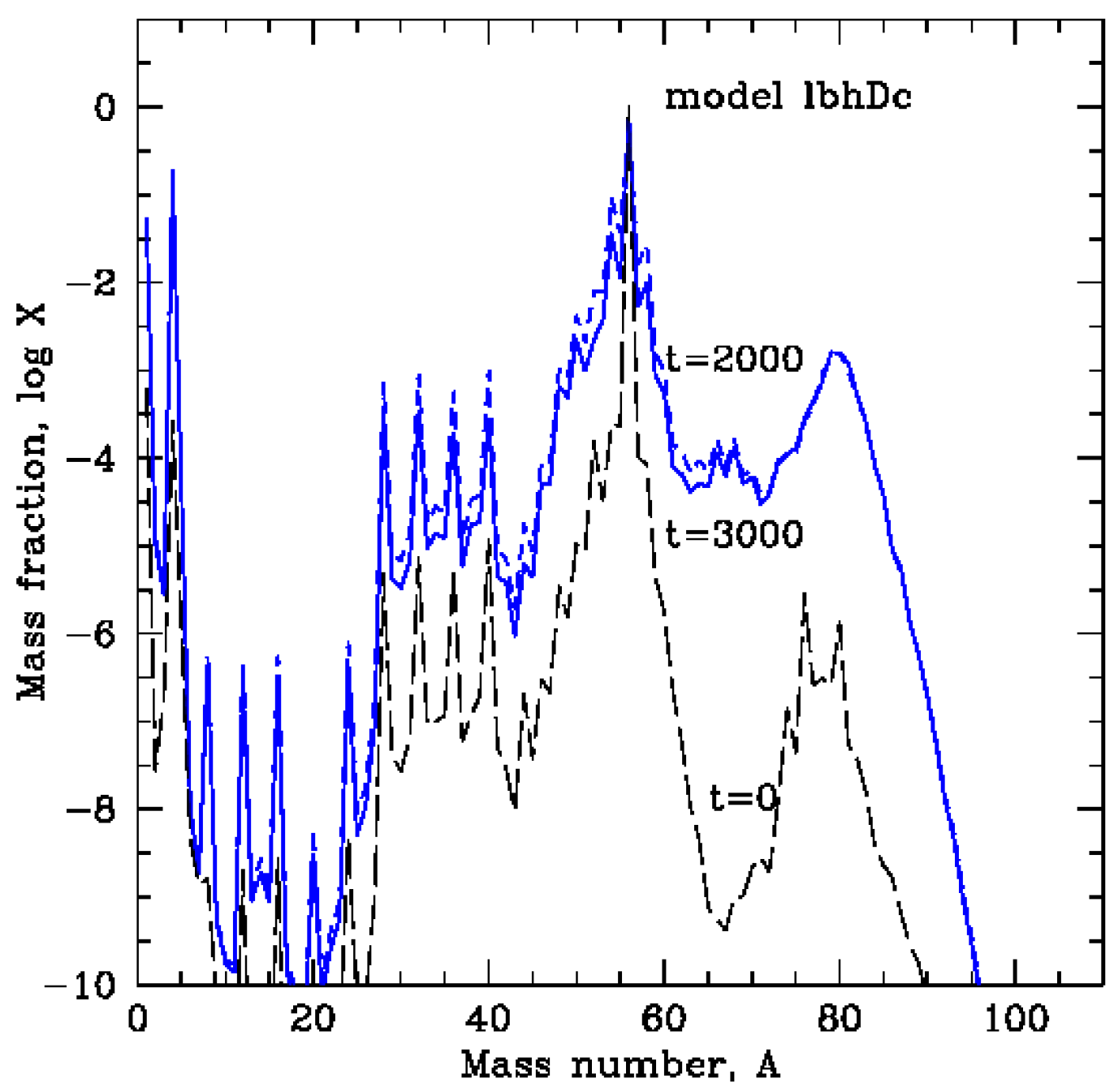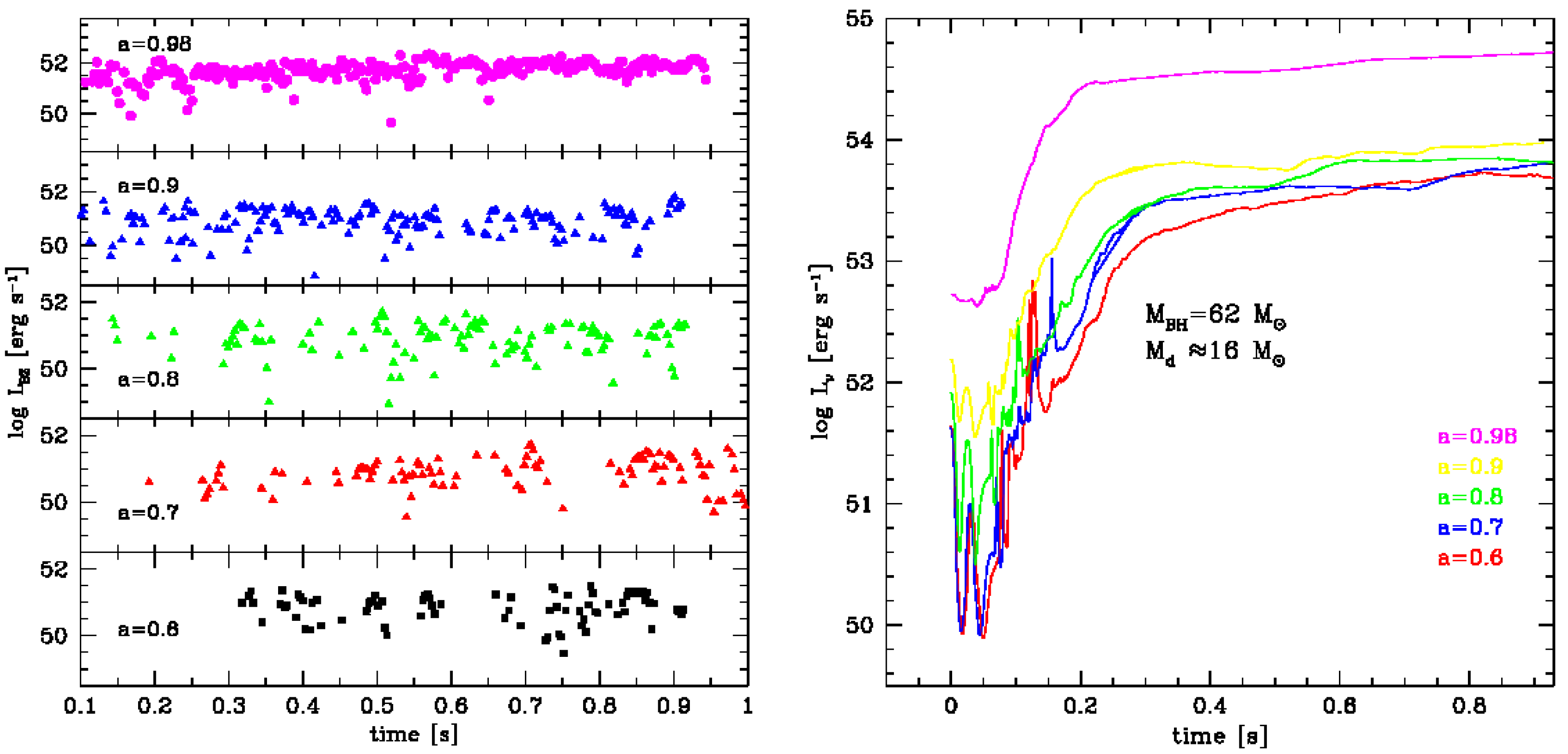Black Hole Accretion in Gamma Ray Bursts
Abstract
:1. Introduction
2. Accretion Flow in the GRB Engine
2.1. Equation of State
2.2. Neutrino Cooling of the Accretion Flow in GRBs
2.3. GR MHD Scheme
2.4. Example Simulation Results
3. Nucleosynthesis of Heavy Elements in the GRB Engine
4. Gravitational Wave Source GW150914
4.1. Merger of Binary BHs
4.2. Weak GRB Powered by Neutrino Emission
5. Conclusions
- We have carried out numerical GR MHD simulations of the magnetized torus accreting onto BH in the GRB central engine. The EOS is no longer assumed to be of an ideal gas, but accounts for the proper microphysics and neutrino cooling of the GRB engine.
- The neutrino emission and absorption processes account for an additional pressure component in the plasma, and the species are partially degenerate. The resulting density and temperature, as well as the electron fraction, are then taken into account when determining the nuclear equilibrium conditions.
- We determine the abundances of heavy elements (above Helium, up to the mass number of ∼100), which are synthesized in the accretion disk in GRB engine, and in the winds that are magnetically launched from its surface. The observational signatures of radioactive decay of some of the unstable isotopes can be, for instance, the emission lines seen in the X-rays (in principle, in the NuSTAR range), and also in the faint emission in lower energy band continuum (i.e., “kilonova” or “macronova” scenario).
- We compute and compare the efficiencies of the GRB jet powered through the neutrino annihilation, and the Blandfrod-Znajek mechanism. We find that the constraints of a moderate BH spin and a small disk mass to the BH mass ratio, are in tentative agreement with the Advanced LIGO and Fermi data, if the latter was really coincident with the GW event.
- A definite answer and a test for our scenario will be possible if further searches for the GW events will provide more data, also for their electromagnetic counterparts, in both gamma rays and lower energies.
Acknowledgments
Author Contributions
Conflicts of Interest
References
- Chen, W.X.; Beloborodov, A.M. Neutrino-cooled Accretion Disks around Spinning Black Holes. Astrophys. J. 2007, 657, 383–399. [Google Scholar] [CrossRef]
- Di Matteo, T.; Perna, R.; Narayan, R. Neutrino Trapping and Accretion Models for Gamma-Ray Bursts. Astrophys. J. 2002, 579, 706–715. [Google Scholar] [CrossRef]
- Janiuk, A.; Yuan, Y.F. The role of black hole spin and magnetic field threading the unstable neutrino disk in gamma ray bursts. Astron. Astrophys. 2010, 509, A55. [Google Scholar] [CrossRef]
- Janiuk, A.; Yuan, Y.F.; Perna, R.; Di Matteo, T. Instabilities in the Time-Dependent Neutrino Disk in Gamma-Ray Bursts. Astrophys. J. 2007, 664, 1011–1025. [Google Scholar] [CrossRef]
- Janiuk, A.; Perna, R.; Di Matteo, T.; Czerny, B. Evolution of a neutrino-cooled disc in gamma-ray bursts. Mon. Not. R. Astron. Soc. 2004, 355, 950–958. [Google Scholar] [CrossRef]
- Kohri, K.; Mineshige, S. Can Neutrino-cooled Accretion Disks Be an Origin of Gamma-Ray Bursts? Astrophys. J. 2002, 577, 311–321. [Google Scholar] [CrossRef]
- Kohri, K.; Narayan, R.; Piran, T. Neutrino-dominated Accretion and Supernovae. Astrophys. J. 2005, 629, 341–361. [Google Scholar] [CrossRef]
- Popham, R.; Woosley, S.E.; Fryer, C. Hyperaccreting Black Holes and Gamma-Ray Bursts. Astrophys. J. 1999, 518, 356–374. [Google Scholar] [CrossRef]
- Reynoso, M.M.; Romero, G.E.; Sampayo, O.A. Precession of neutrino-cooled accretion disks in gamma-ray burst engines. Astron. Astrophys. 2006, 454, 11–16. [Google Scholar] [CrossRef]
- Barkov, M.V.; Baushev, A.N. Accretion of a massive magnetized torus on a rotating black hole. New Astr. 2011, 16, 46–56. [Google Scholar] [CrossRef]
- Janiuk, A.; Mioduszewski, P.; Moscibrodzka, M. Accretion and Outflow from a Magnetized, Neutrino Cooled Torus around the Gamma-Ray Burst Central Engine. Astrophys. J. 2013, 776, 105. [Google Scholar] [CrossRef]
- Janiuk, A.; Bejger, M.; Charzynski, S.; Sukova, P. On the possible gamma-ray burst-gravitational wave association in GW150914. New Astr. 2017, 51, 7–14. [Google Scholar] [CrossRef]
- Yuan, Y.-F. Electron-positron capture rates and a steady state equilibrium condition for an electron-positron plasma with nucleons. Phys. Rev. D 2005, 72, 013007. [Google Scholar] [CrossRef]
- Lattimer, J.M.; Swesty, D.F. A generalized equation of state for hot, dense matter. Nucl. Phys. A 1991, 535, 331–376. [Google Scholar] [CrossRef]
- Setiawan, S.; Ruffert, M.; Janka, H.-Th. Non-stationary hyperaccretion of stellar-mass black holes in three dimensions: Torus evolution and neutrino emission. Mon. Not. R. Astron. Soc. 2004, 352, 753–758. [Google Scholar] [CrossRef]
- Reddy, S.; Prakash, M.; Lattimer, J.M. Neutrino interactions in hot and dense matter. Phys. Rev. D 1998, 58, 013009. [Google Scholar] [CrossRef]
- Gammie, C.F.; McKinney, J.C.; Tóth, G. HARM: A Numerical Scheme for General Relativistic Magnetohydrodynamics. Astrophys. J. 2003, 589, 444–457. [Google Scholar] [CrossRef]
- Noble, S.C.; Gammie, C.F.; McKinney, J.C.; Del Zanna, L. Primitive Variable Solvers for Conservative General Relativistic Magnetohydrodynamics. Astrophys. J. 2006, 641, 626–637. [Google Scholar] [CrossRef]
- Abramowicz, M.; Jaroszynski, M.; Sikora, M. Relativistic, accreting disks. Astron. Astrophys. 1978, 63, 221–224. [Google Scholar]
- Fishbone, L.G.; Moncrief, V. Relativistic fluid disks in orbit around Kerr black holes. Astrophys. J. 1976, 207, 962–976. [Google Scholar] [CrossRef]
- Blandford, R.D.; Znajek, R.L. Electromagnetic extraction of energy from Kerr black holes. Mon. Not. R. Astron. Soc. 1977, 179, 433–456. [Google Scholar] [CrossRef]
- Wallerstein, G.; Iben, I., Jr.; Parker, P.; Boesgaard, A.M.; Hale, G.M.; Champagne, A.E.; Barnes, C.A.; Käppeler, F.; Smith, V.V.; Hoffman, R.D.; et al. Synthesis of the elements in stars: Forty years of progress. Rev. Mod. Phys. 1997, 69, 995–1084. [Google Scholar] [CrossRef]
- Hix, W.R.; Meyer, B.S. Thermonuclear kinetics in astrophysics. Nucl. Phys. 2006, 777, 188–207. [Google Scholar] [CrossRef]
- Li, L.X.; Paczynski, B.P. Transient Events from Neutron Star Mergers. Astrophys. J. 1998, 507, L59. [Google Scholar] [CrossRef]
- Piran, T.; Nakar, E.; Rosswog, S. The electromagnetic signals of compact binary mergers. Mon. Not. R. Astron. Soc. 2013, 430, 2121–2136. [Google Scholar] [CrossRef]
- Janiuk, A. Nucleosynthesis of heavy elements in gamma ray burst engines. Astron. Astrophys. 2014, 568, A105. [Google Scholar] [CrossRef]
- Abbott, B.P.; Abbott, R.; Abbott, T.D.; Abernathy, M.R.; Acernese, F.; Ackley, K.; Adams, C.; Adams, T.; Addesso, P.; Adhikari, R.X.; et al. Observation of Gravitational Waves from a Binary Black Hole Merger. Phys. Rev. Lett. 2016, 116, 061102. [Google Scholar] [CrossRef] [PubMed]
- Connaughton, V.; Burns, E.; Goldstein, A.; Blackburn, L.; Briggs, M.S.; Zhang, B.-B.; Camp, J.; Christensen, N.; Hui, C.M.; Jenke, P.; et al. Fermi GBM Observations of LIGO Gravitational-wave Event GW150914. Astrophys. J. Lett. 2016, 826, L6. [Google Scholar] [CrossRef]
- Greiner, J.; Burgess, J.M.; Savchenko, V.; Yu, H.-F. On the Fermi-GBM Event 0.4 s after GW150914. Astrophys. J. Lett. 2016, 827, L38. [Google Scholar] [CrossRef]
- Janiuk, A.; Charzynski, S.; Bejger, M. Long gamma ray bursts from binary black holes. Astron. Astrophys. 2013, 560, A25. [Google Scholar] [CrossRef]
- Janiuk, A.; Proga, D.; Moderski, R. On the Duration of Long GRBs: Effects of Black Hole Spin. Astrophys. J. 2008, 687, 433–442. [Google Scholar] [CrossRef]
- Löffler, F.; Faber, J.; Bentivegna, E.; Bode, T.; Diener, P.; Haas, R.; Hinder, I.; Mundim, B.C.; Ott, C.D.; Schnetter, E.; et al. The Einstein Toolkit: A community computational infrastructure for relativistic astrophysics. Class. Quantum Grav. 2012, 29, 115001. [Google Scholar] [CrossRef]
- Kocsis, B.; Haiman, Z.; Loeb, A. Gas pile-up, gap overflow and Type 1.5 migration in circumbinary discs: General theory. Mon. Not. R. Astron. Soc. 2012, 427, 2660–2679. [Google Scholar] [CrossRef]
- Abbott, B.P.; Abbott, R.; Abbott, T.D.; Abernathy, M.R.; Acernese, F.; Ackley, K.; Adams, C.; Adams, T.; Addesso, P.; Adhikari, R.X.; et al. Astrophysical Implications of the Binary Black-hole Merger GW150914. Astrophys. J. Lett. 2016, 818, L22. [Google Scholar] [CrossRef]
- Spera, M.; Mapelli, M.; Bressan, A. The mass spectrum of compact remnants from the PARSEC stellar evolution tracks. Mon. Not. R. Astron. Soc. 2015, 451, 4086–4103. [Google Scholar] [CrossRef]
- McKinney, J.C.; Gammie, C.F. A Measurement of the Electromagnetic Luminosity of a Kerr Black Hole. Astrophys. J. 2004, 611, 977–995. [Google Scholar] [CrossRef]
- Loeb, A. Electromagnetic Counterparts to Black Hole Mergers Detected by LIGO. Astrophys. J. Lett. 2016, 819, L21. [Google Scholar] [CrossRef]
- Perna, R.; Lazzati, D.; Giacomazzo, B. Short Gamma-Ray Bursts from the Merger of Two Black Holes. Astrophys. J. Lett. 2016, 821, L18. [Google Scholar] [CrossRef]
- Zhang, B. Mergers of Charged Black Holes: Gravitational-wave Events, Short Gamma-Ray Bursts, and Fast Radio Bursts. Astrophys. J. Lett. 2016, 827, L31. [Google Scholar] [CrossRef]
- 1Curvature of spacetime is described by curvature tensor—the Riemman tensor (20 independent components), which can be decomposed into sum of Ricci tensor (10 independent components) and Weyl tensor (10 independent components). For vacuum solutions of Einstein equations Ricci tensor vanishes, so curvature is described by Weyl tensor only. In the Newman-Penrose formalism components of Weyl tensor are encoded as five complex Weyl scalars , ... , . These are different components of curvature tensor, which have different physical interpretation. describes the outgoing radiation for an asymptotically flat spacetime.




© 2017 by the authors. Licensee MDPI, Basel, Switzerland. This article is an open access article distributed under the terms and conditions of the Creative Commons Attribution (CC BY) license ( http://creativecommons.org/licenses/by/4.0/).
Share and Cite
Janiuk, A.; Bejger, M.; Sukova, P.; Charzynski, S. Black Hole Accretion in Gamma Ray Bursts. Galaxies 2017, 5, 15. https://doi.org/10.3390/galaxies5010015
Janiuk A, Bejger M, Sukova P, Charzynski S. Black Hole Accretion in Gamma Ray Bursts. Galaxies. 2017; 5(1):15. https://doi.org/10.3390/galaxies5010015
Chicago/Turabian StyleJaniuk, Agnieszka, Michal Bejger, Petra Sukova, and Szymon Charzynski. 2017. "Black Hole Accretion in Gamma Ray Bursts" Galaxies 5, no. 1: 15. https://doi.org/10.3390/galaxies5010015
APA StyleJaniuk, A., Bejger, M., Sukova, P., & Charzynski, S. (2017). Black Hole Accretion in Gamma Ray Bursts. Galaxies, 5(1), 15. https://doi.org/10.3390/galaxies5010015




